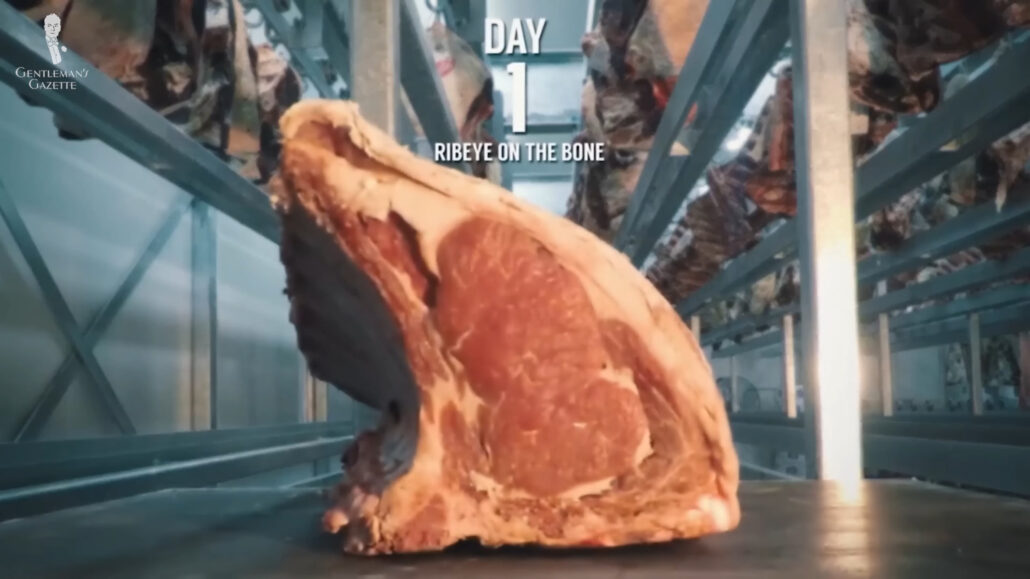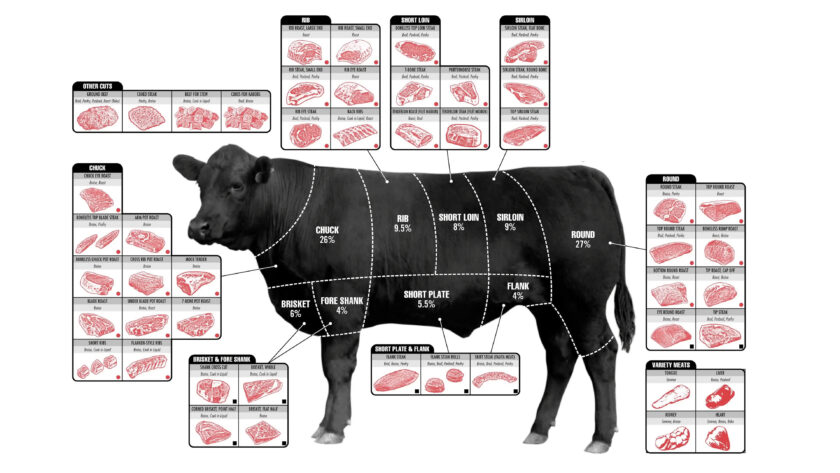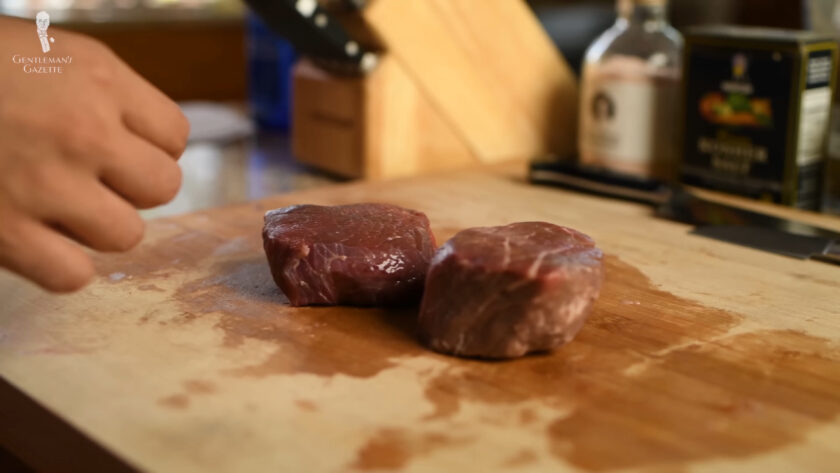Exceptional Steaks Start with Excellent Information
Steak. For many, it’s their favorite meal: a treat at a restaurant or a point of pride in their home cooking repertoire. Steak is such an important food in many cultures that entire restaurants are dedicated to perfecting it, and what makes a “perfect steak” is hotly debated.
Even though it’s a deceptively simple dish, requiring only a bit of seasoning like salt and pepper and some heat, there are many things to know about steak before you get started grilling, searing, or even ordering one. Therefore, this article will discuss what exactly a steak is, the characteristics of a good one, and the best cuts to buy.
“The only time to eat diet food is while you’re waiting for the steak to cook”
Julia Child
This video is part of a series! See all of the installments:
Part I – The Best Types of Steak, Characteristics, and Cuts
Part II – How To Buy the Best Steak for Your Money
Part III – How To Cook The Perfect Steak
What a Steak Is

It may seem like an overly simplistic question, but there is, in fact, a bit of nuance to explaining exactly what a “steak” is: it isn’t just any old cut of meat.
The actual definition is as follows: steak is a cut of meat, usually beef, sliced perpendicular to the muscle fibers that may or may not include a bone. While this definition can apply to other types of meat, like lamb, pork, and even tuna, this particular series of articles will focus specifically on beef steaks, a staple in Western cultures.

“Still, he thought, it’s an adult’s body we got here, no question about that. There’s the pot belly that comes with a few too many good steaks, a few too many bottles of Kirin beer, a few too many poolside lunches where you had the Reuben or the French dip instead of the diet plate.”
Stephen King

KEEP THIS IN MIND
The Realities of Steak Consumption
It is important to be frank and honest when it comes to certain controversial aspects of consuming meat, especially steak.
Steak is an expensive, resource-intense food that is damaging to the environment. Cattle are not always raised under humane conditions, and the use of antibiotics in animals has been linked to growing antibiotic resistance in humans.
Furthermore, beef is by no stretch of the imagination a healthy food. In fact, the World Health Organization links regular consumption of red meat to an increased risk of cancer. While many attempts have been made to reframe red meat as healthy, such as part of a “paleo diet,” scientific consensus does not support this perspective.
Ultimately, everyone must choose for themselves if or how they consume red meat, and that requires being honest about its realities. Unless you are on a special diet prescribed by a medical professional, however, we feel that steak, in moderation, can be integrated into a healthy lifestyle.
FAQ: Steak Types, Characteristics, and Cuts
What makes a piece of meat a steak?
Technically, a steak is any cut of meat sliced perpendicular to the muscle fibers. Therefore, a cut can be a steak regardless of the animal from which it is cut.
Are all steaks beef steaks?
Not, they are not. While today the most common type of steak is beef, although steaks can also be cut from lamb, pork, and fish like tuna or marlin.
What makes a steak taste good?
Steak tastes good because it is both flavorful and tender. Flavor, imparted through flavor-bearing molecules found especially in fatty meat, makes the steak taste good. Tenderness makes the steak pleasant to eat, as it is not overly tough, and improves the juiciness, enhancing the flavor.
What makes a steak tender?
Tenderness is the result of two main factors. The first is how often the muscle group from which the meat came was exercised: the less the muscle was exercised, the better-tasting the meat is. Second, the ratio of muscle, collagen, and fat in the steak.
What is the proper ratio of muscle, collagen, and fat in a steak?
For the best possible taste, a piece of steak should consist of minimally-exercised muscle, almost no connective tissue, and a fine web of marbled fat; thick and heavy pockets of fat are too large to melt during cooking and will become tough and tacky.
What makes a steak flavorful?
Flavor is imparted by the fattiness of the steak, the diet of the cows from which the meat was made, and how the meat was aged.
What are the differences between grass-fed and corn-fed cows?
Grass-fed cows are fed a diet of grass, hay, and shrubbery, usually in open pasturage. They are usually raised under more human conditions with less artificial treatment of their meat, but their meat also tends to be less fatty due to their diets and less tender due to their regular movement. Corn-fed cows are slaughtered after spending time in a feedlot while being aggressively fattened on grains like corn or soy. Their meat is generally fattier and more tender.
What is the difference between dry-aging and wet-aging?
In dry aging, meat is suspended under carefully controlled climatic conditions for several weeks’ time. Microbes on the surface of the meat impart a distinctive aroma and unique texture. In wet aging, the meat is wrapped in protective, moist layers and aged for a few days to a couple of weeks. This method is the most common type of aging employed today.
What are the primal cuts of beef?
The primal cuts are the chunks of meat initially separated from the carcass of an animal during butchering. For beef, these cuts are the round, loin, rib, and chuck.
What are the most common cuts of steaks?
There are generally reconned to be 15 types of beef cuts, defined by the location on the cow from which they are cut. These cuts include skirt, Denver steaks, beef brisket, beef shank, flank steak, t-bone, strip, flap, ribeye, cube, filet, rump steak, London broil, sirloin, flat iron, tomahawk steak, and hanger steak.
What are the best cuts of beef?
In our opinion, the superlative cuts of steak are ribeye, tenderloin, strip, t-bone & porterhouse, and top sirloin.
What is considered the best cut of steak?
Conventionally, filet mignon is considered to be the superior cut of steak. But the fact of the matter is, the best steak cut is entirely a matter of personal preference.
Characteristics of a Great Steak
Great Steaks are Tender and Flavorful


When defining what makes a truly fantastic steak, your primary concern should be how tender and flavorful the steak is.
What Makes a Steak Tender
Defining “Tenderness”

The importance of tenderness in a steak cannot be overestimated: tender steaks are easier and more pleasant to chew, and nobody’s idea of a good steak includes a dining experience that resembles chewing on a piece of old leather!
While steaks can be tenderized with a meat-tenderizing mallet, the simplest way to achieve a tender steak is to start with a tender cut of beef. When it comes to tenderness, not all types of steaks are created equal, and no matter how it is cooked or prepared, meat can only be marginally improved from its initial tenderness.
When considering tenderness, let’s first look at the characteristics of the steak itself: ensuring tenderness while cooking is discussed in the third installment in this series.

Muscle Use When the Animal Was Alive
Just as humans exercise different muscles to different degrees, the same is true for cattle. The less a given muscle was used by the cow in question, the more tender the resulting cut of meat will be.
For example, the muscles along the backbone, which constitute many fine and expensive cuts, are used much less than the hips and shoulders, which end up as cheaper cuts.

The Ratio of Muscle, Collagen, and Fat
A steak contains three main types of bodily matter, not counting a bone: muscle, collagen, which is a type of connective tissue that holds muscle together, and fat. Muscle is the primary substance of the steak, fat provides flavor, and collagen provides structure.
During cooking, connective tissues do not have enough time to break down without adversely affecting the flavor of the steak; therefore, tender types of steak should contain less connective tissue overall so that it cannot impact the flavor generally.
Finely marbled fat will melt during cooking, but thicker pockets of fat will not; this excess fat also compromises tenderness. This is why finely but intensely marbled Wagyu or Kobe beef is so prized!

To summarize, the most tender types of steak will come from around the backbone of the cow, have very little connective tissue, and have finely marbled fat. For these reasons, as well as the fact that the more tender muscles are often smaller, you can expect to pay more for tender cuts of steaks.
What Makes a Steak Flavorful
Fantastic Flavor Comes from the Meat Itself

While the flavor of the steak can be improved by seasonings that might be added just before or during cooking, the nature of the meat itself also plays a major role in ensuring good flavor.
The main components that contribute to flavor are the amount of fat in the meat, the diet of the animal it came from, and how the meat has been aged.
Fat


Fat is the main flavor component in steak. Meat is mostly composed of muscle tissue, which is composed, in turn, mainly of water. Flavor-carrying molecules are repelled by water, but they dissolve into fat. Fat, therefore, effectively enhances the flavor. As a further consideration, fat also adds to the juiciness of the steak.
Diet
The diet of the animal from which the steak is made also affects the flavor of the meat. In the world of beef, the two primary diets for cattle are grain-based and grass-based.

Grain-Fed Cows
For the most part, grain-fed cows are left to roam free in open pastures for their first six to twelve months. After that, however, they’re moved into feedlots, which are no longer pastoral environments, but more concentrated areas. The cows are rapidly fattened in the feedlots with grains such as corn or soy. Some cows are even given hormones to help them grow faster and antibiotics to help increase their survivability in the heavily concentrated and sometimes unsanitary living conditions of the feedlots. As you might imagine, these feedlots and the conditions therein are one of the principal complaints when considering the inhumane treatment of beef cattle.

Grass-Fed Cows
Unlike grain-fed cows, grass-fed cattle are often left to graze for the entirety of their lives before going to the slaughterhouse. While the term grass-fed isn’t a legal definition, according to best practices, it typically implies that cow will subsist mainly on a diet of grass, hay, or shrubbery. Grass-fed cows typically have less fat in their meat because grass is less nutritionally dense than grain. Grazing cows also tend to move around more, making their meat generally tougher.

Understanding Beef
Labeling
As it is the norm, grain-fed beef is often labeled purely as “beef,” whereas grass-fed or grass-finished, which captures the flavors of both feeds, is usually labeled as such. Note that the United States Department of Agriculture (USDA) does not regulate the labeling of grass-fed beef, so the discerning shopper may want to inquire further with their butcher or grocer.
At the end of the day, the impact that diet has on the flavor of the meat and its larger ethical considerations are a matter of personal choice: you should choose what tastes best to you. We believe that if flavor is your aim, traditional grain-fed beef is going to be your best bet, although some people may prefer the flavor of grass-fed beef.
Remember also that, in general, it always pays to know where your steak comes from, as the characteristics of the cattle will have an impact on the quality of the meat.
Aging


Aging is the process by which microbes and enzymes act upon meat to help break down its connective tissue, increasing both tenderness and flavor: it is, essentially, controlled decomposition. There are two primary methods of aging beef: Dry Aging and Wet Aging.

With meat, it isn’t better to be
Fresh? (No!)
While one might initially assume that a freshly butchered beef cut would be more flavorful, the opposite is true. Recently slaughtered beef is tough and flavorless, as its connective tissues are all still intact. While some grocery stores advertise “non-aged” beef, even this meat is still aged for at least a few days. We feel that it is best to avoid beef sold in this way because the decision to forgo aging is a hallmark of lower-quality types of steak whose suboptimal flavor would not benefit from additional aging.

Wet-Aged Beef
Most beef today is wet-aged by way of vacuum-sealing cuts of beef in plastic bags. This process helps keep the meat fresh for a longer period of time and reduces the loss of water within the meat, meaning a higher value for the vendor, as steak is sold by weight.
Furthermore, the wet-aging process takes less time than dry-aging, usually 4 to 10 days at a minimum, and helps retain the appetizing red color of fresh meat, which is seen as desirable by many consumers. Just because we’ve already discussed how the loss of water weight can lead to more flavor, that doesn’t mean that wet aging is necessarily inferior. Some vendors even start with dry aging and switch to wet aging to get the best of both worlds.

Dry-Aged Beef
In the traditional dry-aging process, steaks are aged by hanging them for about 30 days; the beef flavor intensifies due to the water loss. Moreover, microbes on the outer surfaces of the meat are allowed to create a distinctive aroma and textured exterior.
Today, meat lovers often choose dry-aged beef over wet-aged beef because they like the stronger flavor. Generally, a standard grocer won’t carry dry-aged beef, while a reputable butcher often will. Furthermore, only premium cuts are typically dry-aged because lower-quality cuts like flat-iron, chuck, or skirt steaks would degrade rather than improve due to the lower and less evenly distributed fat content.
Dry aging is a delicate and expensive process, as the meat must be stored at near-freezing temperatures in a humid environment (35-38 °F, or 1.5 To 3.5 °C, with a humidity of 50-60%). Proper dry aging can take two to six weeks, and approximately a third or more of the weight is lost as moisture leaves the meat.
Ultimately, our suggestion is to try both wet- and dry-aged steaks and see which you prefer. Once you have a favorite, take notes so you can get exactly what you like during future visits to the grocer or butcher.
Learn how to buy the best steaks!
Types of Steaks and Steak Cuts
What a Cut of Steak Means

There are many types of steak cuts, which refers to the part of the cow from which the steak was sourced. The most tender cuts come from the loin and rib around the backbone, and as they typically have the best texture and flavor, these are the cuts we will focus on today.
We believe the top five cuts for tenderness and flavor are:
- Ribeye
- Tenderloin
- Strip
- T-Bone & Porterhouse
- Top Sirloin
While they are all worth eating, many will likely attest that the best combination of flavor and tenderness comes from the first three cuts on our list. Of course, you might also enjoy other cuts, like a flank or flat-iron steak, but as we believe that the five cuts listed here represent the best combination of texture and flavor, they will remain the focus of our discussion.
“The sauce to meat is ceremony / Meeting were bare without it”
From MacBeth by William Shakespeare
Ribeye Steak

As its name implies, this steak is cut from the rib section of the cow. Also known as a Delmonico steak, Scotch fillet, or entrecôte, it can also be called prime rib when slow-roasted. In the United States, a terminological distinction is made: “ribeye” refers to the cut when the bone has been removed, whereas “rib steak” refers to the cut if the bone remains attached. In other parts of the world, these terms are largely interchangeable.

Raphael Says:
“It’s my opinion that the ribeye represents the best choice for those who prize flavor above all else; for its well-marbled fat and a high degree of tenderness, the flavor of ribeye is second to none.”
Strip Steak (New York Strip)

This cut is also known by a host of other names, including the New York Strip and Kansas City Strip. Sourced from the short loin, the strip is another cut of meat that is low in connective tissue, with the muscle having been rarely utilized by the cow, resulting in a very tender cut of beef.

Preston Says:
“The fine marbling of the strip imparts considerable flavor; in this regard, the strip is generally second only to the ribeye. As a bonus, strip steaks can also be used to make richly flavorful roast beef! Yum!”
Tenderloin / Filet Mignon

This cut, sourced from the center of the loin regions, is aptly named as it is the most tender cut of meat on a cow. It is also known as the filet in France, the fillet in the United Kingdom, and the eye fillet in Oceania.
The three main “cuts” of the tenderloin are, in order from largest to smallest, the butt, the center-cut, and the tail. The butt end is usually suitable for carpaccio, an Italian dish consisting of thinly sliced cuts of raw meat, the center cut for portion-controlled steaks like the coveted filet mignon and Chateaubriand, and the tail for recipes where small cuts of beef are used, such as Stroganoff.
Filet mignon, which means “small” or “dainty” in French, is sliced from the small end of the center cut, whereas Chateaubriand, named for the 19th-century French ambassador, François-René de Chateaubriand, comes from the large end.
The average cow will only provide about 3.5 pounds of tenderloin, with about 2.5 pounds suitable for Chateaubriand and one pound for filet mignon. The weight of the tail portion will vary from 0.5 of a pound to almost nothing. As you might imagine, the tenderloin is, therefore, the most expensive cut by weight.

Kyle Says:
“As it is leaner than the ribeye or strip, tenderloin is the better choice for those who prefer great texture over flavor; it’s often described as being ‘melt-in-your-mouth’ tender. At the same time, because it’s not as flavorful as the ribeye or strip, the tenderloin is often wrapped in bacon or served with a sauce to bolster the flavor profile. The choice is yours!”
T-Bone & Porterhouse


Both the T-bone and the porterhouse cuts are sourced from the short loin of the cow. As you might expect, the T-bone steak is named for the distinctively shaped bone which holds it together. Somewhat confusingly, the porterhouse, whose name comes either from an early-1800s restaurant in New York called the Porter House or a similarly named hotel in Georgia, also has a T-shaped bone, as both cuts are taken from the same region of the animal. Importantly, however, the two cuts are not the same.
While both a T-bone and a porterhouse are bone-in steaks that contain a T-shaped bone surrounded by a tenderloin on one side and a strip on the other, the difference between the cuts lies in the quantity of meat in each of these two sections.

Both T-bones and porterhouses contain a large section of strip steak. Porterhouse steaks are cut from the rear end of the short loin and thus include a larger section of tenderloin. Conversely, T-bone steaks are cut closer to the front end of the short loin and contain a smaller section of tenderloin.

The many meanings of
Porterhouse
As if the situation in North America weren’t confusing enough, the term “porterhouse” also has different definitions outside of the United States. In Britain and the countries of the Commonwealth, a porterhouse is a UK sirloin steak, that is, a US strip steak, on the bone, without the tenderloin – though some British butchers now offer American-style porterhouses, as well. Meanwhile, in New Zealand and Australia, a Porterhouse refers to a strip steak off the bone.
In general, both T-bones and porterhouses are both fairly large cuts and as such, are fairly expensive – and best shared among friends!
Top Sirloin

The top sirloin steak cut is very simply named, as it’s sourced from the upper portion of the cow’s sirloin section, just behind the short loin and under the hip, above the bottom sirloin. While other cuts from the sirloin section, such as the flat-bone and round-bone sirloin steaks, feature more bone and tougher muscle, the top sirloin does not and is more desirable for that reason.
Additionally, the top sirloin is a fairly affordable cut and is the cheapest, on average, of the cuts we have discussed in this article. Given this combination of desirability and affordability, the top sirloin is one of the most popular cuts in America today.

In Brazil, one of the most popular types of steak is the picanha, which is cut from the sirloin cap. The cap contains several larger veins, and if you trim off everything past the third vein, you end up with the picanha, which is very flavorful and tender. Another popular steak is the tri-tip steak, a triangular piece of with a tapered tip cut from the bottom of the sirloin. It can also be used to make a tri-tip roast.

Nathan Says:
“Though top sirloin is less tender, less flavorful, and leaner than the other cuts on this list, it isn’t sorely lacking in any of these categories. For the individual who likes to purchase and enjoy steak fairly regularly, then top sirloin is a great budget alternative.”
Conclusion

With the information we’ve laid out above, you should now be suitably familiar with the basic characteristics of a quality steak, as well as the unique attributes of our top five cuts.
This is only the first part of the process of enjoying a great steak, of course; after deciding what you want, you’ve got to go out and buy your steaks and then cook them properly!
To learn more about these two facets of the experience, consult the latter two parts of this Steak Guide: Part II covers how to buy a steak, and Part III deals with cooking and serving techniques.
Bon Appétit!
Let us know in the comments what characteristics you most value in a fine steak.
Outfit Rundown












